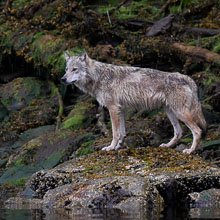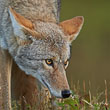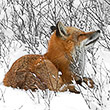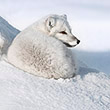Availability: Limited Edition Print; RF Stock (??)
In the Field
Arctic Fox at Rest. Cape Churchill, MB, Canada. October 25, 2004.
When you travel to the Arctic, most photographers have Polar Bears at the top of their "must-photograph" list. While Polar Bears are fascinating and thrilling animals to see and photograph, I have to admit that during my last trip to the tundra I was at least equally excited about the prospect of photographing Arctic Foxes. This particular individual made my trip! He/she was both calm and cooperative and managed to find a way to sit in a nearly perfect position and setting. Plus, it came out during the only hour of sunshine we saw that day!
Photographically it was a fairly straight-forward situation - the biggest challenge came in choosing an aperture that kept the fox and foreground in sharp focus while producing a pleasingly smooth out-of-focus background.
Behind the Camera
Arctic Fox at Rest. Cape Churchill, MB, Canada. October 25, 2004.
Digital Capture; Compressed RAW (NEF) format; ISO 200.
Nikon D2H with Nikon 200-400 mm f/4G ED-IF AF-S VR lens @ 400 mm (600 mm equivalent with digital conversion factor) supported on bean bag.
1/2000s @ f5.6; +0.3 stop exposure compensation from matrix-metered exposure setting.
At the Computer
Arctic Fox at Rest. Cape Churchill, MB, Canada. October 25, 2004.
RAW Conversion to 16-bit TIFF, including first-pass sharpening, using Phase One's C1 Pro.
All further digital correction on 16-bit TIFF file using Adobe's Photoshop CS2, including selective saturation enhancement, selective lens blur, selective application of cooling filter, and selective sharpening for web output.
Conservation
Arctic Fox at Rest. Cape Churchill, MB, Canada. October 25, 2004.
Ten percent of the revenue generated by this image will be donated to the Yellowstone to Yukon Conservation Initiative.
Species Status in Canada*: Not "Endangered" or "Threatened".
In Canada the Arctic Fox (Alopex lagopus) is not listed as an endangered species and, as such, is not afforded any legal protection (it is still considered a relatively important commercial species in Canada, although low fur prices in recent years have reduced the occurrence of hunting of this species). Recent documented northward expansion of the range of the Red Fox (which is a primary predator of the Arctic Fox) may prove to be threat to Canada's Arctic Foxes in the future. It is possible this is an indirect consequence of global warming.
The Arctic Fox is threatened with extinction in Sweden, Finland, and mainland Norway. As such, both the foxes and their dens have been legally protected for decades (since 1928 in Sweden, 1930 in Norway, and Finland since 1940).
The Yellowstone to Yukon (Y2Y) Conservation Initiative seeks to ensure that the world-renowned wilderness, wildlife, native plants, and natural processes of the Yellowstone to Yukon region continue to function as an interconnected web of life, capable of supporting all of its natural and human communities, for current and future generations.
*as determined by COSEWIC: The Committee on the Status of Endangered Wildlife in Canada

























